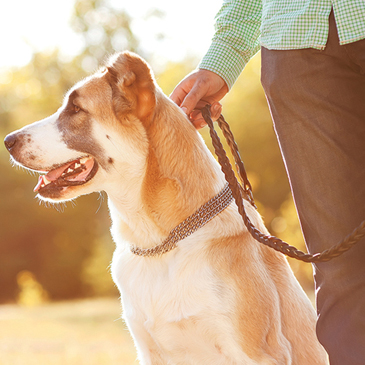There are a lot of different types of leads to choose from and with different purposes.
Regular leads are typically sold for different sizes of dog (small, medium and large) and are designed to allow the dog to walk freely at heel. They will allow the dog to walk just outside of your stride but no further. Tab or show leads are shorter, thinner versions of these, and are designed for training or precision work such as in competition and showing. These allow the dog to run in step with you and stay close enough to ensure they are performing correctly and following your directions.
Training leads vary from 1.5m to 3m in length, they give the dog more space and room to work away from you, but only approximately 2-3 strides away. They can be useful for training exercises where you need your dog to maintain a small distance from you, or on walks to allow your dog a bit more freedom to potter about but easily recalled to heel or reeled in from the lead as needed.
Double leads allow for two dogs to be walked on one lead. There are two forms of these, a specially designed lead for two dogs or alternatively a ‘couple’ extension with two clips that attach to the dogs collars and a ring at the other end for your lead to attach to. This equipment works best with well-trained, obedient dogs as it can restrict their abilities to stop and sniff without pulling their companion around as well. These don’t tend to work well with dogs of different sizes or different activity levels as both dogs need a certain amount of space and to walk at their own pace. With larger breeds, it’s worth remembering that you need to be able to hold double the weight on one lead.
Retractable leads are useful for dogs that can’t be let off in open spaces but still need freedom and space to roam. The leads consist of a bulky plastic box in which the nylon cord is reeled in and stored and can be extended or retracted by the handler in order to give the dog more or less freedom on the lead. It is important to keep dogs close in busy areas, as these thin cords can cause accidents and injuries to other dogs or walkers if they accidently become tangled in them. Making sure the lead is suitable for the size and weight of your dog is worth doing as well, as the leads can snap off if not sized correctly to your dog. Most pet shops will have knowledgeable staff able to help you find the right retractable lead for your dog. If your dog is unfamiliar with a retractable lead, you will need to spend some time training him with it and ensuring he doesn’t use the freedom to head off at high speed pulling you along too.
In terms of options, there’s an abundance of different styles and materials to choose from, for example, waterproof nylon, long lasting leather or simple chains. However, it is important to choose a well-made durable lead that is easy to clip onto the dog’s collar or harness and will take his weight and strength reliably each time. Some leads have padded handles or offer some shock absorbance which can help protect your hands and arms if your dog is an enthusiastic puller and there are even some hands-free options available now for running or jogging while attached to your dog.



Hi
Has anyone got any advice on getting a puppy used to a harness?
I have introduced it slowly a few times a day (with cheese as an incentive) over the last week but can’t get it on or off Audrey without her snapping and getting very distressed.
I thought maybe it was the weight and rigidity of the RabbitGoo harness so purchased a soft No-pull harness from Pets at Home today but it took 3 of us and lots of cheese to get it on. Once on she is great and isn’t bothered at all. she doesn’t pull and seems less interested in traffic.
She is a typical border collie cross at 4 months old and has that horrid “chase the car!” predisposition which makes me anxious.
In every other way she is great but I simply can’t get the harness over her head.
Shall I give up and try a step in harness? And are they safe for wriggly puppies who tend to pull?
Hi Jane, she sounds lovely!
We’d recommend persistence with the harness, these things take time. Using treats and reassurance is a great start. It’s always best to remain calm when putting the harness on- you want it to be a good experience for little Audrey.
Speak with a local behaviourist if you have any concerns.
Thanks, Karri
I can’t take my dog out as he pulls me to much we have tried a halter but it stress him out I don’t no wat to do eny sugtion please
I have a Labrador, and in my experience, slip leads work best. They’re easy to adjust and help me guide my dog during walks without any problems. That’s why I think slip leads are just perfect for bigger dogs like my Labrador. This is the exact lead that I use for my dog https://ezydog.com.au/luca-rope-leash/